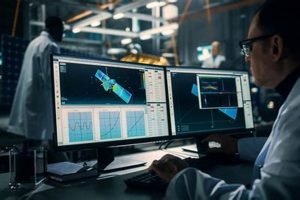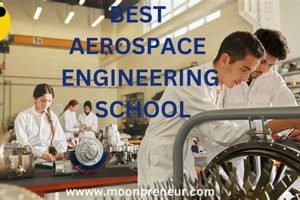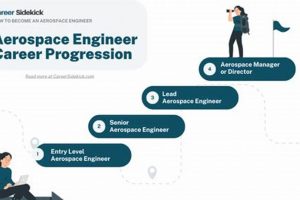A compilation of institutions offering academic programs focused on the design, development, and testing of aircraft and spacecraft. These programs typically encompass a broad range of topics, including aerodynamics, propulsion, structures, and control systems. For example, a student consulting such a compilation might identify multiple universities with specialized curricula in astronautics or hypersonics.
Access to a comprehensive inventory of these institutions is crucial for prospective students seeking relevant educational opportunities. It allows for informed decision-making, facilitating comparison of program strengths, research facilities, faculty expertise, and geographical location. Historically, such resources were less accessible, relying on printed directories or word-of-mouth. The proliferation of online databases has significantly improved access and transparency, aiding in the identification of suitable academic pathways.
The following sections will elaborate on key considerations when evaluating institutions, prominent programs, resources for identifying suitable options, and the projected career trajectories for graduates in this field.
Guidance for Evaluating Academic Institutions
Selecting an appropriate academic program for aerospace engineering requires careful evaluation of several key factors. The following points provide a framework for prospective students.
Tip 1: Curriculum Rigor and Specialization: Investigate the specific courses offered within each program. Determine if the curriculum aligns with individual interests, such as spacecraft design, propulsion systems, or aerodynamics. A program with strong specialization options can provide a competitive advantage.
Tip 2: Faculty Expertise and Research Opportunities: Examine the faculty profiles, focusing on their research areas and publications. Seek programs where faculty members are actively involved in cutting-edge research. Furthermore, investigate available research opportunities for undergraduate and graduate students, as practical experience is invaluable.
Tip 3: Accreditation and Program Ranking: Verify the program’s accreditation status from recognized engineering accreditation bodies. While rankings are not the sole determinant of quality, they can provide a general indication of program reputation and resources.
Tip 4: Facilities and Resources: Assess the availability of relevant facilities, such as wind tunnels, propulsion labs, and advanced computational resources. These facilities are essential for hands-on learning and research.
Tip 5: Location and Networking Opportunities: Consider the geographical location of the institution. Proximity to aerospace companies or government research labs can provide valuable internship and networking opportunities.
Tip 6: Cost and Financial Aid: Evaluate the overall cost of attendance, including tuition, fees, and living expenses. Research available financial aid options, scholarships, and grants.
Careful consideration of these factors will aid in selecting an academic program that best aligns with individual career goals and provides a strong foundation for success in the aerospace industry.
The subsequent sections will present prominent institutions and further resources.
1. Accreditation Standards
Accreditation standards serve as a critical filter for any comprehensive compilation of aerospace engineering programs. These standards, typically established by organizations such as ABET (Accreditation Board for Engineering and Technology), ensure that programs meet minimum criteria for curriculum content, faculty qualifications, and available resources. A listing of aerospace engineering institutions that omits consideration of accreditation status is inherently incomplete and potentially misleading. The causal relationship is direct: accredited programs have undergone rigorous evaluation, providing assurance of a certain level of quality.
The importance of accreditation lies in its function as a recognized benchmark. Employers often prioritize graduates from accredited programs, as accreditation provides confidence in the student’s foundational knowledge and preparedness for professional practice. Furthermore, accreditation may be a prerequisite for licensure as a professional engineer. For instance, a prospective student reviewing a list of institutions offering aerospace engineering degrees should verify ABET accreditation to ascertain that the program adheres to recognized industry standards. Failure to do so could limit future career prospects.
In summary, accreditation standards are an indispensable component of any accurate and useful listing of aerospace engineering institutions. These standards provide a mechanism for quality assurance, inform prospective students and employers, and ultimately contribute to the integrity of the profession. Disregarding accreditation status renders a “aerospace engineering colleges list” unreliable, and potentially detrimental to the decision-making process of those seeking to advance their education and career in aerospace engineering.
2. Curriculum Specializations
Curriculum specializations constitute a critical element within a comprehensive resource of aerospace engineering programs. Institutions offering these programs often provide focused areas of study beyond the core curriculum, allowing students to develop expertise in specific domains. The presence, breadth, and depth of these specializations directly influence the relevance and appeal of a particular institution for prospective students with defined interests. For example, one institution might emphasize hypersonics, while another focuses on autonomous systems or space mission design. A detailed compilation will articulate these differentiations, enabling informed decisions based on career aspirations. Failure to adequately represent these curriculum nuances diminishes the utility of the resource.
The practical significance of understanding curriculum specializations lies in its impact on career preparedness. Employers in the aerospace industry frequently seek candidates with specific skill sets and knowledge bases. An individual who has specialized in composite materials, for instance, may be more competitive for roles involving aircraft structural design. Similarly, a background in control systems may be highly advantageous for positions related to drone technology or satellite navigation. Therefore, an articulation of these specializations within a ‘aerospace engineering colleges list’ serves as a direct guide to aligning academic preparation with professional opportunities. Omitting this information creates a disconnect between education and industry needs.
In conclusion, curriculum specializations represent a fundamental aspect of aerospace engineering education and, consequently, a vital component of a well-constructed institutional listing. These specialized tracks allow students to tailor their studies to specific areas of interest and, more importantly, enhance their prospects for targeted career paths. A comprehensive resource will not only identify the institutions but also meticulously detail the available curriculum specializations, facilitating informed choices and promoting effective alignment between academic training and professional goals. The absence of such detailed information renders the resource significantly less valuable.
3. Faculty Research
A crucial dimension of any credible institutional inventory for aerospace engineering programs lies in the scope and impact of faculty research. This component is not merely an ancillary detail; it directly reflects the dynamism and intellectual environment of the academic department. Institutions with active, well-funded research programs typically attract and retain leading experts in the field, creating a stimulating learning environment for students. The presence of robust faculty research is a key differentiator among programs and serves as a significant indicator of program quality and future opportunities for students. For example, universities known for their contributions to hypersonic flight research often boast faculty actively engaged in related projects, providing students with unparalleled access to cutting-edge knowledge and facilities.
The influence of faculty research extends beyond the classroom. Students participating in research projects gain invaluable practical experience, developing skills in experimental design, data analysis, and scientific communication. These experiences enhance their competitiveness for internships, graduate studies, and eventual employment in the aerospace industry. Moreover, faculty research often leads to publications in leading journals and presentations at international conferences, raising the visibility and prestige of the institution. Consider, for instance, a professor specializing in sustainable aviation technologies whose research attracts industry partnerships. This benefits students by exposing them to real-world challenges and potential career paths. A list omitting detailed information on faculty research neglects a critical factor in evaluating an aerospace engineering program.
In summary, the scope and quality of faculty research represent a cornerstone element in evaluating programs. A comprehensive list accurately represents this vital aspect. Students who engage in these research projects develop skills that prepare them for their aerospace career. Moreover, this research serves to elevate the reputation of an institution, fostering innovation and advancement within the aerospace field. A “aerospace engineering colleges list” lacking detailed faculty research information will deprive prospective students of information to make informed choices, and ultimately lead to suboptimal selection.
4. Facilities Access
Access to specialized facilities is a determining factor when assessing the utility of a document compiling aerospace engineering programs. The availability of wind tunnels, propulsion laboratories, flight simulators, advanced materials testing equipment, and high-performance computing resources directly impacts the quality of education and research opportunities. Programs with limited access to such infrastructure are inherently less capable of providing students with the hands-on experience necessary for success in the aerospace industry. The presence of these facilities enables practical application of theoretical knowledge, fostering critical thinking and problem-solving skills. For example, an institution lacking a subsonic wind tunnel cannot adequately support courses on aerodynamics, nor can it facilitate student research on airfoil design.
A listing of institutions should, therefore, explicitly detail the range and capabilities of available facilities. This information allows prospective students to assess the program’s ability to provide a comprehensive and practical learning experience. Furthermore, it enables comparison across institutions, highlighting those that prioritize investment in infrastructure. Consider, for instance, a university boasting a state-of-the-art composite materials testing laboratory. This implies a commitment to advanced research in aircraft structures and provides students with opportunities to work with cutting-edge technologies. The absence of details on facilities significantly diminishes the value of the resource, hindering informed decision-making.
In conclusion, access to specialized facilities is a fundamental requirement for a high-quality aerospace engineering program. As a result, a compilation that fails to provide detailed information on available infrastructure is inherently incomplete. Ensuring that prospective students have access to accurate and comprehensive data on facilities access allows them to make informed decisions, selecting programs that offer the best opportunities for practical learning and career advancement. The inclusion of this information also serves to highlight institutions that are committed to providing their students with a world-class education in aerospace engineering.
5. Location Proximity
The geographic location of academic institutions featured within a compendium of aerospace engineering programs significantly influences educational opportunities and career prospects for students. Proximity to key aerospace industry hubs, government research facilities, and relevant manufacturing centers provides tangible advantages that enhance the overall educational experience.
- Internship and Employment Opportunities
Geographic adjacency to major aerospace companies such as Boeing, Lockheed Martin, or SpaceX facilitates internship and employment possibilities. Students at institutions near these centers often have preferential access to internships, providing valuable real-world experience and networking opportunities that can lead to full-time employment post-graduation. For instance, a university located near NASA’s Johnson Space Center may offer students unique research collaborations and internship placements directly aligned with space exploration initiatives.
- Industry-Academia Collaboration
Universities situated near aerospace clusters often benefit from close collaborations with industry partners. These partnerships can take the form of joint research projects, guest lectures from industry experts, and curriculum development informed by industry needs. This synergy ensures that the academic programs remain relevant and responsive to the evolving demands of the aerospace sector. A university in Silicon Valley, for example, may collaborate with local aerospace startups on projects involving autonomous aerial vehicles or satellite technology.
- Networking and Professional Development
Location influences students’ access to professional networks and career development resources. Being located in an aerospace hub allows students to attend industry conferences, participate in workshops, and interact with professionals from leading companies. These interactions can provide invaluable insights into career paths, industry trends, and professional development opportunities. Students at institutions near major aviation hubs like Seattle or Los Angeles benefit from the frequent presence of aerospace professionals and the associated networking possibilities.
- Access to Government Research Facilities
Proximity to government research facilities, such as NASA centers or Air Force research laboratories, provides opportunities for students to engage in cutting-edge research. These facilities often offer research grants, fellowships, and collaborative projects that allow students to work alongside leading scientists and engineers. A university located near a Department of Defense research facility, for instance, may specialize in areas such as advanced propulsion systems or aerospace materials, providing students with access to unique expertise and resources.
The interplay between an academic institution’s geographic location and its alignment with the aerospace industry contributes significantly to the educational and professional development of its students. A comprehensive “aerospace engineering colleges list” should incorporate location as a critical factor, enabling prospective students to strategically select institutions that offer the greatest advantages in terms of industry access, research opportunities, and career prospects.
6. Program Rankings
Program rankings, while not the sole determinant of institutional quality, represent a readily accessible metric often consulted by prospective students utilizing an “aerospace engineering colleges list”. These rankings, typically published by organizations such as U.S. News & World Report, provide a comparative assessment of aerospace engineering programs based on factors such as peer assessment, research activity, faculty resources, and student selectivity. Their influence on student perceptions and institutional reputation necessitates careful consideration.
- Methodological Variance
Different ranking systems employ distinct methodologies, assigning varying weights to different factors. Consequently, an institution’s ranking can fluctuate significantly depending on the ranking source. For example, one ranking might prioritize research funding while another emphasizes student-faculty ratio. Therefore, relying on a single ranking without understanding its underlying methodology provides an incomplete and potentially misleading assessment.
- Correlation with Resources
Higher-ranked programs often correlate with greater financial resources, allowing for investment in state-of-the-art facilities, recruitment of prominent faculty, and provision of enhanced student support services. This advantage can translate to improved educational outcomes and increased research productivity. For instance, an institution with a substantial endowment may be able to offer more competitive graduate stipends, attracting top-tier students.
- Impact on Recruitment
Program rankings can significantly impact an institution’s ability to attract high-caliber students. Prospective applicants often view rankings as a proxy for program quality and prestige, leading to increased application volume for highly ranked programs. This heightened competition can further enhance the program’s selectivity and reputation, creating a self-reinforcing cycle.
- Limitations in Scope
Program rankings typically focus on quantifiable metrics, often overlooking qualitative aspects of the educational experience such as teaching quality, mentorship opportunities, and the overall learning environment. Furthermore, rankings may not adequately capture the nuances of specialized programs or niche research areas. Therefore, relying solely on rankings without considering these qualitative factors can result in a suboptimal decision.
Ultimately, program rankings provide a readily available, albeit imperfect, tool for navigating an “aerospace engineering colleges list”. Prospective students should critically evaluate ranking methodologies, consider a range of ranking sources, and, most importantly, supplement this information with thorough research on individual programs, including factors such as curriculum specializations, faculty expertise, and available facilities, to make an informed decision aligning with their individual academic and career goals.
7. Financial Aid
Financial aid serves as a pivotal consideration for prospective students navigating a “aerospace engineering colleges list”. The accessibility and availability of financial assistance significantly impact a student’s ability to pursue an aerospace engineering education, influencing both the choice of institution and the feasibility of completing the program. A comprehensive understanding of financial aid options is, therefore, essential for informed decision-making.
- Federal and State Grants
Federal and state grant programs, such as Pell Grants and state-sponsored need-based grants, provide financial assistance that does not require repayment. These grants are typically awarded based on demonstrated financial need, as determined by standardized application processes. For example, a student from a lower-income family might qualify for a Pell Grant, which can significantly reduce the cost of tuition at an aerospace engineering program listed in an inventory of academic institutions. The availability of these grants broadens access to higher education for students from diverse socioeconomic backgrounds.
- Scholarships
Scholarships represent another crucial form of financial aid. These awards are typically merit-based, recognizing academic achievement, leadership qualities, or specific talents. Many aerospace engineering programs offer scholarships specifically targeted towards students pursuing studies in this field. Organizations like the American Institute of Aeronautics and Astronautics (AIAA) also provide scholarships to promising aerospace engineering students. Competition for these scholarships can be intense, but they offer a valuable opportunity to reduce the financial burden of tuition and other educational expenses.
- Student Loans
Student loans, both federal and private, constitute a significant source of funding for many students pursuing aerospace engineering degrees. Federal student loans, such as Direct Loans, typically offer lower interest rates and more flexible repayment options compared to private loans. However, students should carefully consider the long-term implications of taking on student loan debt. For example, a student might need to borrow a substantial amount to cover tuition, fees, and living expenses at a highly ranked aerospace engineering program. Understanding loan terms, interest rates, and repayment schedules is crucial for responsible financial planning.
- Work-Study Programs
Work-study programs provide students with the opportunity to earn money to help pay for educational expenses while gaining valuable work experience. These programs are often subsidized by the federal government and offer on-campus or off-campus employment opportunities. For instance, a student participating in a work-study program might work as a research assistant in an aerospace engineering lab, gaining practical skills while contributing to ongoing research projects. Work-study programs can help students reduce their reliance on loans and gain valuable professional experience relevant to their field of study.
The availability and effective utilization of financial aid resources directly influence the accessibility and affordability of aerospace engineering programs listed in a comprehensive institutional inventory. Understanding the nuances of grant programs, scholarship opportunities, student loan options, and work-study programs empowers prospective students to make informed decisions, ensuring that financial constraints do not preclude them from pursuing their educational and career aspirations in the aerospace field.
Frequently Asked Questions
The following addresses prevalent inquiries regarding institutions offering programs in aerospace engineering. This information is intended to provide clarity and support informed decision-making.
Question 1: Are all institutions listed as offering aerospace engineering programs equally reputable?
No. Reputation varies significantly. Factors such as accreditation status, faculty expertise, research funding, and industry connections contribute to an institution’s overall standing. Comprehensive due diligence is advised.
Question 2: How frequently is a “aerospace engineering colleges list” updated to reflect changes in program offerings or accreditation status?
Update frequency varies depending on the source. Reputable resources typically update annually or biannually to incorporate changes in curriculum, faculty, accreditation, and other relevant information. Verify the update date for accuracy.
Question 3: Is a higher ranking in a “aerospace engineering colleges list” always indicative of a superior educational experience?
Not necessarily. Rankings are based on specific methodologies and may not fully capture the nuances of individual program strengths or the specific needs of a prospective student. Consider program specializations, research opportunities, and available facilities in addition to rankings.
Question 4: What role does geographical location play in selecting an institution from a “aerospace engineering colleges list”?
Geographical location can influence access to internships, industry connections, and networking opportunities. Proximity to aerospace industry hubs or government research facilities can provide significant advantages. Consider career goals and desired industry exposure.
Question 5: Do all institutions listed offer equivalent levels of financial aid and scholarship opportunities?
No. Financial aid packages and scholarship opportunities vary widely. Research each institution’s financial aid policies, application requirements, and available resources to determine affordability and potential funding sources.
Question 6: How can a prospective student verify the accuracy of information presented within a “aerospace engineering colleges list”?
Cross-reference information with official institutional websites, accreditation agencies (e.g., ABET), and professional organizations (e.g., AIAA). Contact the aerospace engineering department directly to confirm specific details about program offerings, faculty expertise, and research opportunities.
In summary, critical evaluation and verification are essential when utilizing resources identifying academic programs. Factors beyond a simple compilation of institutions must be considered.
The following section will explore career prospects for graduates.
Concluding Remarks
The preceding exploration of resources delineating institutions offering aerospace engineering programs underscores the multifaceted nature of selecting an appropriate academic path. Factors such as accreditation, specialized curricula, faculty research, facilities access, geographic location, program rankings, and financial aid options must be meticulously evaluated. A simplistic reliance on a mere compilation of institutions, without comprehensive due diligence, carries significant risk.
Prospective students are, therefore, urged to approach any ‘aerospace engineering colleges list’ as a starting point, not a definitive answer. Rigorous investigation, critical analysis, and direct engagement with institutions of interest remain paramount. The future of aerospace engineering relies on well-informed, highly skilled graduates; the onus rests on each student to ensure their academic preparation aligns with the demands of this dynamic field.







